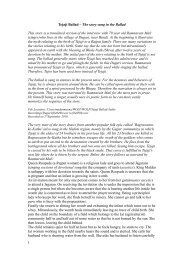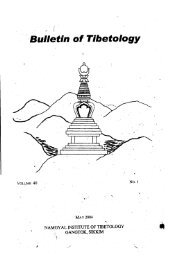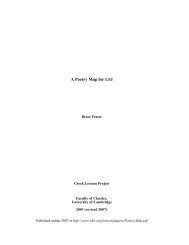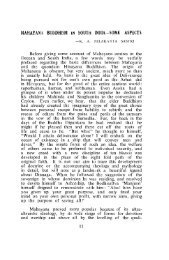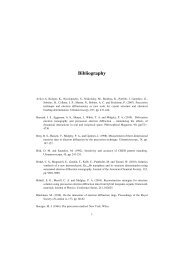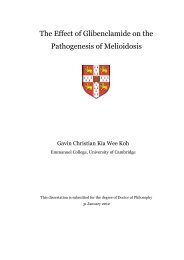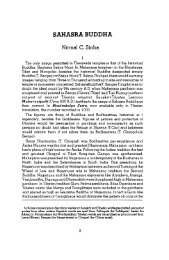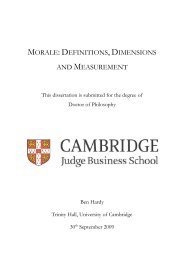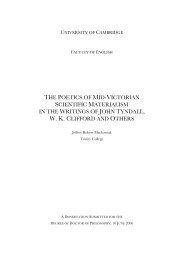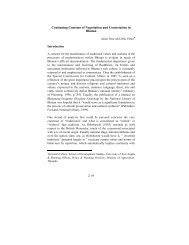The Crusades, the Genoese and the Latin East - DSpace at ...
The Crusades, the Genoese and the Latin East - DSpace at ...
The Crusades, the Genoese and the Latin East - DSpace at ...
Create successful ePaper yourself
Turn your PDF publications into a flip-book with our unique Google optimized e-Paper software.
In any case, Pope Urban III wrote fourteen letters to <strong>the</strong> ecclesiastical <strong>and</strong> lay personnel<br />
of <strong>the</strong> crusader st<strong>at</strong>es, all of which concern <strong>Genoese</strong> properties <strong>and</strong> rights in <strong>the</strong> <strong>L<strong>at</strong>in</strong> <strong>East</strong>. Six of<br />
<strong>the</strong> letters specifically concern <strong>the</strong> unpaid debts for Gibelet over a period of seventeen years: We<br />
censu illo per annos decem et septem. ' Hugh II's reluctance to pay <strong>the</strong> census is described in <strong>the</strong><br />
letter as an `act of rebellion, ' as <strong>the</strong> pope wrote in his letters th<strong>at</strong> `sicut p<strong>at</strong>er eius fecit solita<br />
rebellione. '476 <strong>The</strong>se six letters are very similar to each o<strong>the</strong>r, which makes <strong>the</strong> small differences<br />
between <strong>the</strong>m of some interest.<br />
<strong>The</strong> first two letters were written on 11 March 1186. <strong>The</strong> first was addressed to `dilecto<br />
filio Hugoni, filio Hugonis de Gibelleto, ' <strong>and</strong> <strong>the</strong> second was written to <strong>the</strong> p<strong>at</strong>riarch of<br />
Antioch 477 <strong>The</strong> first letter was sent directly to Hugh III. <strong>The</strong> pope clearly avoided addressing<br />
Hugh or his l<strong>at</strong>e fa<strong>the</strong>r as <strong>the</strong> lords of Gibelet, but simply used `Hugh of Gibelet'. He wrote th<strong>at</strong><br />
<strong>the</strong> church <strong>and</strong> <strong>the</strong> city of Genoa had asked him to act because Hugh's fa<strong>the</strong>r had not paid his<br />
duty for Gibelet, which is property th<strong>at</strong> he had held on Genoa's behalf. <strong>The</strong> pope bluntly stressed<br />
th<strong>at</strong> Hugh III must pay because he is `his fa<strong>the</strong>r's successor' 'tu debes ex eius successione.... P479<br />
Finally, Urban entrusted fur<strong>the</strong>r dealing on this m<strong>at</strong>ter with <strong>the</strong> p<strong>at</strong>riarchs of Jerusalem <strong>and</strong><br />
Antioch <strong>and</strong> <strong>the</strong> bishops of Tripoli <strong>and</strong> Gibelet.<br />
<strong>The</strong> next letter was addressed to <strong>the</strong> p<strong>at</strong>riarch of Antioch. <strong>The</strong> pope maintained his ra<strong>the</strong>r<br />
severe tone. Urban mentioned <strong>the</strong> letter th<strong>at</strong> he had already written to Hugh III about<br />
his fa<strong>the</strong>r's<br />
unpaid debts, using <strong>the</strong> same words <strong>and</strong> adding `sicut p<strong>at</strong>er eius fecit, solita rebellione<br />
contempn<strong>at</strong>' [my emphasis]. <strong>The</strong> pope fur<strong>the</strong>r mentioned th<strong>at</strong> previous letters by <strong>the</strong> l<strong>at</strong>e popes<br />
Alex<strong>and</strong>er III <strong>and</strong> Lucius III were ignored. Lucius III's letter is not available in <strong>the</strong> archives of <strong>the</strong><br />
V<strong>at</strong>ican, but <strong>the</strong> reference to such a letter suggests th<strong>at</strong> by 1186, <strong>the</strong> issue of <strong>the</strong> rel<strong>at</strong>ionship <strong>and</strong><br />
commitments between Genoa <strong>and</strong> Gibelet had already required papal involvement for over three<br />
gener<strong>at</strong>ions. Urban concluded his own letter to <strong>the</strong> p<strong>at</strong>riarch in <strong>the</strong> same rigid manner. He<br />
maintained th<strong>at</strong>: `uolumus firmiterque precipiendo m<strong>and</strong>amus qu<strong>at</strong>inus ipsum ad hoc<br />
exequendum moneas <strong>at</strong>tentius et inducas. Quod si ad m<strong>and</strong><strong>at</strong>um nostrum et monita tua facere<br />
forte neglexerit, tu eum appell<strong>at</strong>ione remota ad hec ecclesiastica districtione compellas. X479<br />
See Hans. E Mayer <strong>and</strong> Marie-Luise Favreau `Das Diplom Balduins I fur Genua und Genuas Goldene<br />
Inschrift in der Grabeskirche', Quellen und Forschungen aus italianischen Archiven und Biblio<strong>the</strong>ken<br />
55/56 (1976), 22-95; Benjamin Kedar, `Genoa's Golden Inscription in <strong>the</strong> Church of <strong>the</strong> Holy Sepulchre',<br />
7319.<br />
61 Libri lurium, vol. 1/2, nos. 316-329; Letters 322,325-29 concern Gibelet. <strong>The</strong> l<strong>at</strong>est edition of <strong>the</strong>se<br />
letters is included in Rudolf Niest<strong>and</strong>, Papsturkunden für Kirchen im Heiligen L<strong>and</strong>e (Gottingen, 1985),<br />
letters 130-32,135-37.<br />
477 Hiest<strong>and</strong>, Papsturkunden für Kirchen im Heiligen L<strong>and</strong>e, <strong>the</strong> letter to <strong>the</strong> p<strong>at</strong>riarch of Antioch, no. 131,<br />
pp. 308-9; <strong>the</strong> letter to Hugh of Gibelet, no. 130, pp. 307-8.<br />
s Niest<strong>and</strong>, no. 130, P. 308.<br />
479 Hiest<strong>and</strong>, no. 131, p. 309.<br />
133



